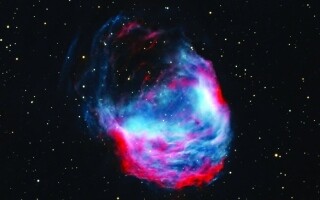
The jellyfish-like object was successfully photographed by astronomers from Abu Dhabi at the astronomical observatory "Khatim" after a 33-hour exposure. This achievement became a significant milestone for the observatory. The nebula is located in the constellation of the Blizzards (or Gemini) and was formed as a result of the explosion of a star resembling the Sun. In the images taken by the observatory, the nebula is represented in red and blue tones due to the gases that were formed as a result of the cosmic explosion, at the time remaining after the star's explosion is depicted as a small blue object called the "white dwarf."
The nebula "Medusa" was discovered in 1955, its diameter is eight light years, that is, light takes eight years to travel from one edge of the nebula to the other. The nebula is located in the Galactic Orion Belt and is at a distance of approximately 1500 light years from Earth. This photograph represents an astronomical picture, reflecting what will presumably happen with our Sun in the future, when it finishes its life cycle and transforms into a white dwarf at the center of a similar nebula.
Despite the fact that the distances to the nebula "Medusa" are relatively small on a cosmic scale, the photograph also shows four small galaxies, located to the right of the nebula. At the same time, the distances to "Medusa" constitute 1500 light years, these galaxies are at immense distances from Earth: the first galaxy is located at a distance of 736 million light years, the second - 1.4 billion light years, the third - 1.7 billion light years and the fourth - 1.8 billion light years.
This remarkable astronomical image from the "Khatim" observatory provides a rare representation of the depths of the universe and conveys a representation of the future of stars, indicating the distant future of our Sun.













